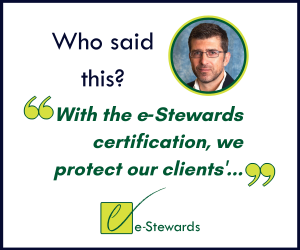
There are a couple other instances in the report where Redemtech fails to provide necessary details and e-Stewards ends up looking better than it would have if all the information were given. UNICOR has also improved prison safety and if UNICOR programs are used by a R2 certified company they have to follow R2’s own worker safety guidelines. According to UNICOR, these programs and have also caused a reduction of recidivism and lowered the costs of Federal prison systems. This is not mentioned in the Redemtech report but UNICOR has its positives it teaches e-waste recycling to offenders and helps them learn valuable skills that might assist them in rejoining the workforce as soon as they are released. So, what’s the story behind this? R2 does not prohibit the use of UNICOR, a company that employs prisoners and is used by the government. The report also puts an emphasis on R2’s allowance for prison labor because BAN has prohibited this practice for all e-Stewards certified companies.

Why do two types of training justify, “Very limited guidance?” Under the, “Provides training and guidance provided to auditor,” category, e-Stewards has a, “Yes,” while R2 has a, “Very limited guidance.” Their reasoning for writing this was because there are two different types of training to the auditors under the R2 program. I have other concerns about Redemtech’s reporting. BAN only employs about 4 people so there does not seem to be a need for such a giant fee especially since the annual fee goes towards earning “the right to use the e-Steward logo,” –Jim Puckett, one of the founders of BAN. Because of these fees, I am concerned that e-Stewards might not reflect the most responsible companies but rather the responsible ones that are willing to pay a huge amount. There is also no mention of the initiation fee of up to $25,000.

For instance, the category, “Ensures institutional and financial support of the standard,” says that e-Stewards has BAN as the holding body and it even says that there is an annual fee that goes to supporting BAN which is correct but it fails to mention that this annual fee can be up to $125,000. The report forgoes any reporting that would make R2 appear good or e-Stewards look bad. I have found that, for the most part, the comparison seems factual but the language is written in a way that makes e-Stewards appear significantly superior to R2 even if that is not the case. EPA and developed by ISRI, the Institute of Scrap Recycling Industries, Inc, which represents the Recycling industry so was the recycler’s view overly considered? I took a look at what Redemtech had to say. Is R2 really that bad? R2 was facilitated by the U.S. So according to their report, R2 in no way compares to e-Stewards. Out of the 18 categories Redemtech has e-Stewards looking favorable in each and every one. Just as the subtitle suggests, the Redemtech report shows a point-by-point comparison of e-Stewards and R2. The report is called E-Waste Recycling Standards: A Side-by-Side Comparison of e-Stewards and R2.

Redemtech, a recycler, reporter of e-waste news, and prominent contributor to e-Stewards (developed by a company called BAN,) has recently released a report comparing these two programs. Responsible Recycling (R2) and e-Stewards are the two major programs that certify electronic recyclers as responsible according to their own standards. Note: This post was written by SEI staff member, Amy Cade.


 0 kommentar(er)
0 kommentar(er)
